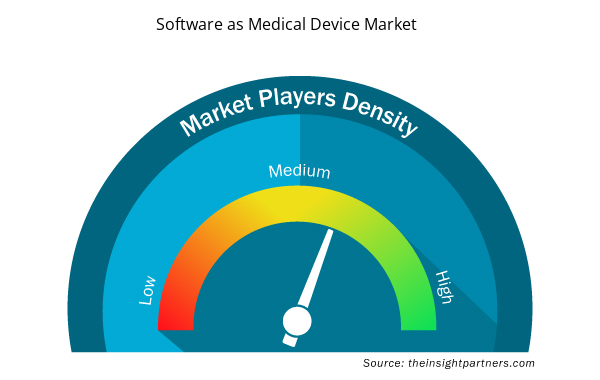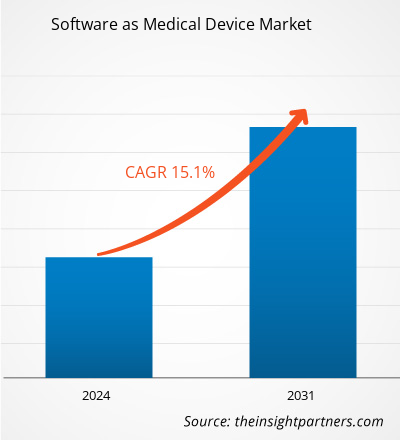医療機器としてのソフトウェアの市場規模は、2023 年の 301.7 億米ドルから 2031 年には 930.8 億米ドルに達すると予測されています。市場は 2023 年から 2031 年にかけて 15.1% の CAGR を記録すると予想されています。ウェアラブル医療機器の増加は、引き続き市場の重要なトレンドとなると思われます。
医療機器市場分析としてのソフトウェア
近年、医療機器としてのソフトウェア (SaMD) は医療の武器として不可欠なツールとなっており、その成長は 2023 年に加速する可能性があります。SaMD やその他のデジタル ソリューションなどの要素により、患者と医療提供者のやり取りが再形成され、データの共有、収集、追跡の威力が明らかになっています。その他の要素としては、Virtual First Care (V1C) の普及が進み、医療提供者が物理的な接触のリスクを負うことなくケアを提供できるようになっています。これにより、遠隔地の病気を管理できるようになります。
医療機器市場の概要としてのソフトウェア
メキシコは、インフラへのソフトウェアベースのデジタルソリューションの組み込みを促進することで、医療のデジタル化を推進することに重点を置いています。同国は前例のない速度で成長しています。過去数十年の間に、メキシコ政府は、医療現場にデジタルツールを実装することで、医療の全体的な品質を向上させるという野心的な取り組みを打ち出しました。同国における全体的なデジタル医療の発展も、市場の成長を促進し、今後数年間にわたって好ましい状況をもたらす可能性があります。さらに、メキシコの60歳以上の高齢者人口は、2010年の6.3%から2050年までに23%に増加すると予想されています。したがって、高齢者人口の増加などの要因により、今後10年間で需要が増加すると予想されます。
要件に合わせてレポートをカスタマイズする
このレポートの一部、国レベルの分析、Excelデータパックなど、あらゆるレポートを無料でカスタマイズできます。また、スタートアップや大学向けのお得なオファーや割引もご利用いただけます。
- このレポートの主要な市場動向を入手してください。この無料サンプルには、市場動向から見積もりや予測に至るまでのデータ分析が含まれます。
医療機器市場の推進力と機会としてのソフトウェア
FDA、SaMDに関する市場優遇の新ガイドライン草案を発表
最近発表されたガイダンスの草案更新では、プロセスが明確化され、合理化されています。新しいガイダンス文書によると、医療機器としてのソフトウェアは、患者と介護者の両方を対象に、臨床意思決定支援ソフトウェア (CDSS) と患者意思決定支援ソフトウェア (PDS) に分類されています。これらの分類ルールでは、体内への侵襲性の程度、接触期間、影響を受ける身体システム、局所的影響と全身的影響など、いくつかの要因が考慮されます。ガイダンスの草案更新は、SaMD 開発の増加も示しています。
新興経済国の開発途上地域
新興経済国の経済と国民一人当たりの所得の上昇に伴い、医療サービスの向上に対する需要も高まっています。医療業界の成長は、ヘルスケアサービスの自動化が進むことで実現しています。世界の市場プレーヤーは新興国での事業拡大のためにこの地域を検討しており、予測期間中に医療機器としてのソフトウェア(SaMD)市場がさらに成長すると予想されています。王国の通信情報技術委員会(CITC)によると、サウジアラビアの消費者のほとんど(54%)が健康管理にテクノロジーを使用し、40%がモバイルデバイスで健康アプリを使用し、残りの14%がウェアラブルテクノロジーを使用していると推定されています。
医療機器市場レポートのセグメンテーション分析としてのソフトウェア
医療機器市場分析としてのソフトウェアの導出に貢献した主要なセグメントは、デバイス タイプ、アプリケーション、および展開タイプです。
- デバイスの種類に基づいて、医療機器としてのソフトウェア市場は、PC/ラップトップ、スマートフォン/タブレット、ウェアラブルデバイスに分かれています。PC/ラップトップセグメントは、2023年に大きな市場シェアを占めました。
- 用途別に見ると、市場はスクリーニングと診断、監視と警告、疾病管理に分類されます。スクリーニングと診断セグメントは、2023年に市場で最大のシェアを占めました。
- 導入タイプ別に見ると、市場はクラウドとオンプレミスに分かれています。2023年にはクラウドセグメントが市場で最大のシェアを占めました。
医療機器としてのソフトウェアの地域別市場シェア分析
医療機器としてのソフトウェア市場レポートの地理的範囲は、主に北米、アジア太平洋、ヨーロッパ、中東およびアフリカ、南米および中米の 5 つの地域に分かれています。
北米が市場を独占しています。人工知能、機械学習、自然言語処理 (NLP) の浸透とデジタル ヘルスケアへの応用が、市場を独占する要因であると考えられます。さらに、スマートフォンやラップトップ ベースのソフトウェア ソリューションによる患者の診断と遠隔監視のための新しいソリューションを提供する主要な市場リーダーの存在も、これらのソリューションの操作、理解、健康状態の分析が容易なため、需要の増加を生み出しています。アジア太平洋地域は、今後数年間で最高の CAGR で成長すると予想されています。
医療機器市場におけるソフトウェアの地域別洞察
予測期間を通じて医療機器市場としてのソフトウェアに影響を与える地域的な傾向と要因は、Insight Partners のアナリストによって徹底的に説明されています。このセクションでは、北米、ヨーロッパ、アジア太平洋、中東、アフリカ、南米、中米にわたる医療機器市場としてのソフトウェアのセグメントと地域についても説明します。

- 医療機器市場におけるソフトウェアの地域別データを入手
医療機器市場レポートのスコープとしてのソフトウェア
| レポート属性 | 詳細 |
|---|---|
| 2023年の市場規模 | 301.7億米ドル |
| 2031年までの市場規模 | 930.8億米ドル |
| 世界のCAGR(2023年~2031年) | 15.1% |
| 履歴データ | 2021-2022 |
| 予測期間 | 2024-2031 |
| 対象セグメント | デバイスタイプ別
|
| 対象地域と国 | 北米
|
| 市場リーダーと主要企業プロフィール |
|
市場プレーヤーの密度:ビジネスダイナミクスへの影響を理解する
医療機器としてのソフトウェア市場は、消費者の嗜好の変化、技術の進歩、製品の利点に対する認識の高まりなどの要因により、エンドユーザーの需要が高まり、急速に成長しています。需要が高まるにつれて、企業は提供内容を拡大し、消費者のニーズを満たすために革新し、新たなトレンドを活用し、市場の成長をさらに促進しています。
市場プレーヤー密度とは、特定の市場または業界内で活動している企業または会社の分布を指します。これは、特定の市場スペースに、その市場規模または総市場価値に対してどれだけの競合相手 (市場プレーヤー) が存在するかを示します。
医療機器としてのソフトウェア市場で事業を展開している主要企業は次のとおりです。
- ヴェレンティウムLLC
- Tietronix Software 社
- S3 コネクテッドヘルス
- チュールケグループ
- 科学グループ
- インゼンティス
免責事項:上記の企業は、特定の順序でランク付けされていません。

- 医療機器市場におけるソフトウェアの主要プレーヤーの概要を入手
医療機器市場におけるソフトウェアのニュースと最近の動向
医療機器としてのソフトウェア市場は、主要な企業出版物、協会データ、データベースを含む一次調査と二次調査後の定性的および定量的データを収集することによって評価されます。医療機器としてのソフトウェア市場におけるいくつかの開発を以下に示します。
- CompliancePath と Ideagen は、進行中の検証アクセラレータ プログラムを拡張してライフ サイエンス関連のソフトウェア製品すべてを対象にする製品検証パートナーシップを締結しました。(出典: CompliancePath、プレス リリース、2020 年 4 月)
- 米国を拠点とするSTAT Health社は、血流を測定する24時間365日インイヤーウェアラブル総合健康製品を発表しました。(出典:STAT Health、プレスリリース、2023年6月)
医療機器市場レポートの対象となるソフトウェアと成果物
「医療機器としてのソフトウェアの市場規模と予測(2021〜2031年)」レポートでは、以下の分野をカバーする市場の詳細な分析を提供しています。
- 医療機器としてのソフトウェア市場の規模と予測(対象範囲に含まれるすべての主要市場セグメントの世界、地域、国レベル)
- 医療機器市場におけるソフトウェアの動向、推進要因、制約、主要な機会などの市場動向
- 詳細なPEST/ポーターの5つの力とSWOT分析
- 主要な市場動向、世界および地域の枠組み、主要プレーヤー、規制、最近の市場動向を網羅した医療機器としてのソフトウェア市場分析
- 市場集中、ヒートマップ分析、主要プレーヤー、医療機器としてのソフトウェア市場の最近の動向を網羅した業界の状況と競争分析
- 詳細な企業プロフィール
- 過去2年間の分析、基準年、CAGRによる予測(7年間)
- PEST分析とSWOT分析
- 市場規模価値/数量 - 世界、地域、国
- 業界と競争環境
- Excel データセット


- Micro-Surgical Robot Market
- Occupational Health Market
- Procedure Trays Market
- Compounding Pharmacies Market
- Trade Promotion Management Software Market
- Legal Case Management Software Market
- Cut Flowers Market
- Mice Model Market
- Vessel Monitoring System Market
- Emergency Department Information System (EDIS) Market

Report Coverage
Revenue forecast, Company Analysis, Industry landscape, Growth factors, and Trends

Segment Covered
This text is related
to segments covered.

Regional Scope
North America, Europe, Asia Pacific, Middle East & Africa, South & Central America

Country Scope
This text is related
to country scope.
よくある質問
North America held the largest market for Software as Medical Device. The growth of the region is attributed to continuous rise in the use of Software as Medical Device, innovations in software designs, and increasing awareness among people regarding the benefits for digital healthcare applications.
The driving factors are increasing adoption of Internet of Things (IoT) & connected devices in healthcare and the advantages offered by Software as Medical Device (SaMD).
Increasing number of wearable medical devices is likely to remain key trends in the market.
S3 Connected Health, BrightInsight, Inc. and CompliancePath are among the top players operating in the Software as Medical Device market.
The software as medical device market size is projected to reach US$ 93.08 billion by 2031.
The market is expected to register a CAGR of 15.1% during 2023–2031.
Trends and growth analysis reports related to Technology, Media and Telecommunications : READ MORE..
The Insight Partners performs research in 4 major stages: Data Collection & Secondary Research, Primary Research, Data Analysis and Data Triangulation & Final Review.
- Data Collection and Secondary Research:
As a market research and consulting firm operating from a decade, we have published and advised several client across the globe. First step for any study will start with an assessment of currently available data and insights from existing reports. Further, historical and current market information is collected from Investor Presentations, Annual Reports, SEC Filings, etc., and other information related to company’s performance and market positioning are gathered from Paid Databases (Factiva, Hoovers, and Reuters) and various other publications available in public domain.
Several associations trade associates, technical forums, institutes, societies and organization are accessed to gain technical as well as market related insights through their publications such as research papers, blogs and press releases related to the studies are referred to get cues about the market. Further, white papers, journals, magazines, and other news articles published in last 3 years are scrutinized and analyzed to understand the current market trends.
- Primary Research:
The primarily interview analysis comprise of data obtained from industry participants interview and answers to survey questions gathered by in-house primary team.
For primary research, interviews are conducted with industry experts/CEOs/Marketing Managers/VPs/Subject Matter Experts from both demand and supply side to get a 360-degree view of the market. The primary team conducts several interviews based on the complexity of the markets to understand the various market trends and dynamics which makes research more credible and precise.
A typical research interview fulfils the following functions:
- Provides first-hand information on the market size, market trends, growth trends, competitive landscape, and outlook
- Validates and strengthens in-house secondary research findings
- Develops the analysis team’s expertise and market understanding
Primary research involves email interactions and telephone interviews for each market, category, segment, and sub-segment across geographies. The participants who typically take part in such a process include, but are not limited to:
- Industry participants: VPs, business development managers, market intelligence managers and national sales managers
- Outside experts: Valuation experts, research analysts and key opinion leaders specializing in the electronics and semiconductor industry.
Below is the breakup of our primary respondents by company, designation, and region:

Once we receive the confirmation from primary research sources or primary respondents, we finalize the base year market estimation and forecast the data as per the macroeconomic and microeconomic factors assessed during data collection.
- Data Analysis:
Once data is validated through both secondary as well as primary respondents, we finalize the market estimations by hypothesis formulation and factor analysis at regional and country level.
- Macro-Economic Factor Analysis:
We analyse macroeconomic indicators such the gross domestic product (GDP), increase in the demand for goods and services across industries, technological advancement, regional economic growth, governmental policies, the influence of COVID-19, PEST analysis, and other aspects. This analysis aids in setting benchmarks for various nations/regions and approximating market splits. Additionally, the general trend of the aforementioned components aid in determining the market's development possibilities.
- Country Level Data:
Various factors that are especially aligned to the country are taken into account to determine the market size for a certain area and country, including the presence of vendors, such as headquarters and offices, the country's GDP, demand patterns, and industry growth. To comprehend the market dynamics for the nation, a number of growth variables, inhibitors, application areas, and current market trends are researched. The aforementioned elements aid in determining the country's overall market's growth potential.
- Company Profile:
The “Table of Contents” is formulated by listing and analyzing more than 25 - 30 companies operating in the market ecosystem across geographies. However, we profile only 10 companies as a standard practice in our syndicate reports. These 10 companies comprise leading, emerging, and regional players. Nonetheless, our analysis is not restricted to the 10 listed companies, we also analyze other companies present in the market to develop a holistic view and understand the prevailing trends. The “Company Profiles” section in the report covers key facts, business description, products & services, financial information, SWOT analysis, and key developments. The financial information presented is extracted from the annual reports and official documents of the publicly listed companies. Upon collecting the information for the sections of respective companies, we verify them via various primary sources and then compile the data in respective company profiles. The company level information helps us in deriving the base number as well as in forecasting the market size.
- Developing Base Number:
Aggregation of sales statistics (2020-2022) and macro-economic factor, and other secondary and primary research insights are utilized to arrive at base number and related market shares for 2022. The data gaps are identified in this step and relevant market data is analyzed, collected from paid primary interviews or databases. On finalizing the base year market size, forecasts are developed on the basis of macro-economic, industry and market growth factors and company level analysis.
- Data Triangulation and Final Review:
The market findings and base year market size calculations are validated from supply as well as demand side. Demand side validations are based on macro-economic factor analysis and benchmarks for respective regions and countries. In case of supply side validations, revenues of major companies are estimated (in case not available) based on industry benchmark, approximate number of employees, product portfolio, and primary interviews revenues are gathered. Further revenue from target product/service segment is assessed to avoid overshooting of market statistics. In case of heavy deviations between supply and demand side values, all thes steps are repeated to achieve synchronization.
We follow an iterative model, wherein we share our research findings with Subject Matter Experts (SME’s) and Key Opinion Leaders (KOLs) until consensus view of the market is not formulated – this model negates any drastic deviation in the opinions of experts. Only validated and universally acceptable research findings are quoted in our reports.
We have important check points that we use to validate our research findings – which we call – data triangulation, where we validate the information, we generate from secondary sources with primary interviews and then we re-validate with our internal data bases and Subject matter experts. This comprehensive model enables us to deliver high quality, reliable data in shortest possible time.


 このレポートの無料サンプルを入手する
このレポートの無料サンプルを入手する